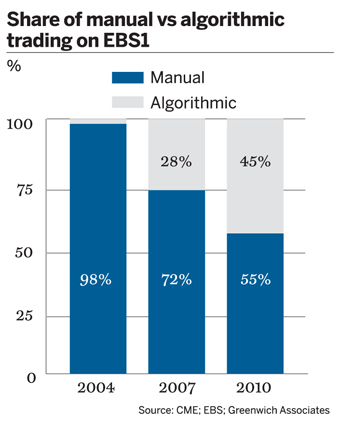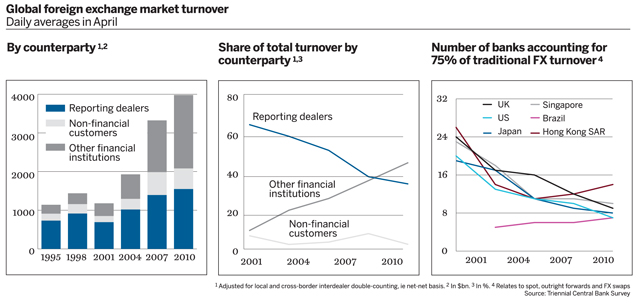Bank-to-bank volumes no longer biggest FX driver
Last year, customer volumes overtook interbank volumes in the foreign exchange market for the first time. Electronic and high-frequency trading help to account for the change, as does the rise of retail participants – but regulatory change is also helping to cement this trend.
When last year's Triennial Central Bank Survey of Foreign Exchange and Derivatives Market Activity report was published by the Bank for International Settlement (BIS), the focus was largely on the fact that daily average turnover had increased by 20% to $4000bn, driven by a 48% growth in spot transactions.
The other notable trend was the growing role of what the BIS classifies as "other financial institutions". The category, which includes non-reporting banks, hedge funds, pension funds, mutual funds, insurance companies and central banks, among others, accounted for 85% of growth.
What garnered little comment, however, was that for the first time, trades for this 'client' segment surpassed the volume of inter-dealer transactions. Reporting dealers accounted for $1548bn of transactions, versus $1900bn by other financial institutions (with the remaining $533bn being made up by non-financial customers).
Electronic trading drives growth
It is clear that electronic trading – and, specifically, algorithmic trading – is helping to drive growth in client volumes. A significant turning point for foreign exchange algorithmic trading came in 2004 when the electronic broker EBS launched EBS Spot Ai, enabling algorithmic trading in spot FX markets using the real-time prices quoted on EBS. In 2005, this service was extended to the major customers of banks, allowing hedge funds and other traders to gain access to the deep liquidity of the inter-dealer markets via their prime brokerage accounts with the biggest FX dealers.
Electronic trading in the foreign exchange markets not only reduces costs and increases liquidity – thus increasing capacity and turnover – but encourages wider participation across different client types. So, since EBS's early innovations, the emergence of high-frequency traders has brought algorithmic trading to the FX market and the proliferation of electronic execution engines has contributed to the rapid growth of online trading by retail investors.
Another development, the continued long-term trend towards greater concentration of FX activity in a handful of global banks, is also turning banks into customers. The guaranteed liquidity offered by the large global players has meant that smaller banks can no longer compete as market makers in the major currency pairs; as a result, while such banks may still make markets in local currencies, they have become customers for trading in the major currencies.
Other shifts
However, Jim Chrystal, co-founder and global head for new products and buy-side sales at Traiana, which operates Harmony, the securities industry's largest post-trade processing network, believes the BIS survey results support other trends that Traiana is seeing in the FX market.
For one thing, Mr Chrystal attributes the growth of bank-to-client volumes to the separation of what have traditionally been seen as sell-side banking activities from those activities managed by the buy-side. He believes it is likely that this shift is related to increasing regulatory pressure on banks to ensure that risk-taking is mitigated.
Volcker changes
The US's recently introduced Volcker Rule, with which banks have to comply by July 2014, specifically prohibits banks from engaging in proprietary trading and means that banks are either winding up their proprietary trading desks or hiving them off into asset management divisions, effectively turning them into customers of the bank.
"There continues to be a roll-out of prop trading operations from banks. Groups are leaving, creating hedge funds and the banks are servicing them,” says Mr Chrystal. “Banks are becoming banks again and they are servicing clients. For this reason, the client-side of the bank/client relationship is generating the majority of FX flow."
But he also thinks that the phenomenal rise in FX volumes is in part due to the rapid growth of the retail trading sector. "The retail FX platforms are generating hundreds of thousands of tickets daily. By some estimates, retail trading can account for up to 15% to 20% of FX turnover,” he says.
Japanese retail investors are the most active, with market estimates suggesting this segment represents 30% or more of spot Japanese yen trading daily.
While the growth in algorithmic and retail electronic trading is expected to continue, fuelled by increased competition and lower transaction costs, so too is the decline in the inter-dealer market and the growth of bank-client business. It is expected that inter-dealer volumes will decline further as banks match more customer trades internally. And as more ex-bank prop traders move into the hedge fund world, the growth of 'client' volumes is likely to continue.




